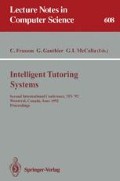Abstract
In this paper we analyse the explanation facilities of several expert systems using a framework based on factors relevant to the structure and content of a generated explanation. We compare this with the lack of such facilities in expert system shells, and lay out criteria for an explanation facility within an expert system shell for education. We then describe their realisation in the explores (explanation oriented expert system) shell, where domain-independent templates allow questions to be asked about the domain of any knowledge base being consulted. In response, the shell generates domain-based explanations, with further information available through follow-up questions related to the original question, the generated explanation, and the available knowledge. This facility allows a user to explore and learn about a knowledge domain, and has implications for the use of expert system shells in education.
The research described in this paper was carried out in the Department of Artificial Intelligence at the University of Edinburgh.
Preview
Unable to display preview. Download preview PDF.
References
J.S. Aikins: Prototypical Knowledge for Expert Systems. Artificial Intelligence 20: 163–210, 1983.
B.G. Buchanan & E.H. Shortliffe (eds.): Rule-Based Expert Systems: The MYCIN Experiments of the Stanford Heuristic Programming Project Reading, MA: Addison-Wesley, 1984.
A.J. Cawsey: Generating Tutorial Explanation Dialogues. In: Proceedings of the 4th Alvey Explanation Workshop, Manchester, 1988.
W.J. Clancey: Tutoring rules for guiding a case method dialogue. International Journal of Man Machine Studies 11: 25–49, 1979.
W.J. Clancey: The Epistemology of a Rule-Based Expert System — a Framework for Explanation. Artificial Intelligence 20: 215–251, 1983.
T. Conlon & P. Cope: Computing in Scottish Education: The first decade and beyond. Edinburgh: Edinburgh University Press, 1989.
G.N. Gilbert: Question and answer types. In: Research and Development in Expert Systems IV, D.S. Moralee (ed), Cambridge University Press, Cambridge, 1987.
D.W. Hasling, W.J. Clancey & G. Rennels: Strategic explanations for a diagnostic consultation system. International Journal of Man Machine Studies 20: 3–19, 1984.
S. Hughes: Question classification in rule-based systems. In: Research and Development in Expert Systems III, M.A. Bramer (ed). Cambridge: Cambridge University Press, 1986.
R. Kass & T. Finin: The Need for User Models in Generating Expert System Explanations. International Journal of Expert Systems 1(4): 345–375, 1988.
A. Kidd: What do users ask? — some thoughts on diagnostic advice. In: Expert Systems '85, M.A. Bramer (ed). Cambridge: Cambridge University Press. 1985.
W.G. Lehnert: The Process of Question Answering. Hillsdale, New Jersey: Lawrence Erlbaum Associates, 1978.
K. McCoy: Correcting Object-Related Misconceptions: How Should The System Respond?. In: Proceedings of COLING '84, 444–447, 1984.
K. McCoy: Generating Context-Sensitive Responses to Object-Related Misconceptions. Artificial Intelligence 41: 157–195, 1989.
K.R. McKeown: Discourse Strategies for Generating Natural Language Text. Artificial Intelligence 27: 1–41, 1985.
K.R. McKeown: Generating Goal-Oriented Explanations. International Journal of Expert Systems 1(4): 377–395, 1988.
M.T. Maybury: Classifying and Reacting to User Feedback to Guide Text Generation. In: Proceedings of the 5th Explanation Workshop, Manchester, 1990.
M. Minsky: A framework for representing knowledge. In: The Psychology of Computer Vision, P. Winston (ed). New York: McGraw-Hill, 1975.
R. Neches, W.R. Swartout & J. Moore: Explainable (and maintainable) expert systems. In: Proceedings of the 9th International Joint Conference on Artificial Intelligence, 382–389, 1985.
A. Newell: The knowledge level. Artificial Intelligence 18: 87–127, 1982.
C.L. Paris: Tailoring Object Descriptions to a User's Level of Expertise. Computational Linguistics 14(3): 64–78, 1988.
E. Sarantinos & P. Johnson: Explanation Dialogue: A computational model of interpreting questions and generating tailored explanations. In: Proceedings of the 5th Explanation Workshop, Manchester, 1990.
A.C Scott, W.J. Clancey, R. Davis & E.H. Shortliffe: Methods for Generating Explanations. In: Rule-Based Expert Systems: The MYCIN Experiments of the Stanford Heuristic Programming Project, B.G. Buchanan & E.H. Shortliffe (eds.). Reading, MA: Addison-Wesley, 1984.
D. Sleeman: UMFE: A User Modelling Front-End subsystem. International Journal of Man Machine Studies 23: 71–88, 1985.
W.R. Swartout: Producing Explanations and Justifications of Expert Consulting Programs. MIT Technical Report no. MIT/LCS/TR-251, 1981.
W.R. Swartout: Knowledge Needed for Expert System Explanation. Future Computing Systems 1(2): 99–114, 1986.
K. Valley: Designing an Expert System Shell for use in Education. In: Proceedings of the PICKET Education Group Conference, Copenhagen, 1988.
K. Valley: Realising the Potential of Expert System Shells in Education. In: Artificial Intelligence and Education: Synthesis and Reflection (Proceedings of the 4th AI & Education conference), D, Bierman, J. Breuker & J. Sandberg (eds.). IOS: Amsterdam, 1989.
K. Valley: The Use of Expert System Shells in Education: an Explanation-Based Approach. Unpublished PhD thesis, University of Edinburgh, 1990.
J.W. Wallis & E.H. Shortliffe: Customized Explanation Using Causal Knowledge In: Rule-Based Expert Systems: The MYCIN Experiments of the Stanford Heuristic Programming Project, B.G. Buchanan & E.H. Shortliffe (eds.). Reading, MA: Addison-Wesley, 1984.
J.L. Weiner: BLAH, A System Which Explains its Reasoning. Artificial Intelligence 15: 19–48., 1980.
Author information
Authors and Affiliations
Editor information
Rights and permissions
Copyright information
© 1992 Springer-Verlag Berlin Heidelberg
About this paper
Cite this paper
Valley, K. (1992). Explanation in expert system shells: a tool for exploration and learning. In: Frasson, C., Gauthier, G., McCalla, G.I. (eds) Intelligent Tutoring Systems. ITS 1992. Lecture Notes in Computer Science, vol 608. Springer, Berlin, Heidelberg. https://doi.org/10.1007/3-540-55606-0_70
Download citation
DOI: https://doi.org/10.1007/3-540-55606-0_70
Published:
Publisher Name: Springer, Berlin, Heidelberg
Print ISBN: 978-3-540-55606-0
Online ISBN: 978-3-540-47254-4
eBook Packages: Springer Book Archive

